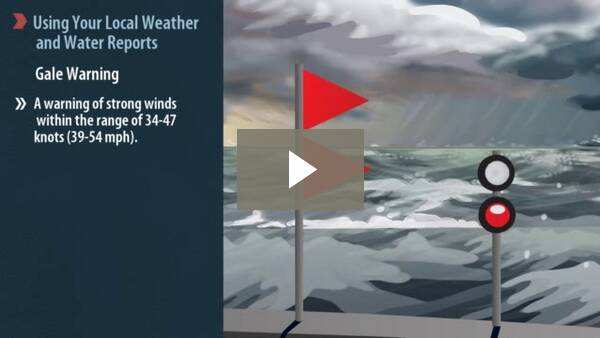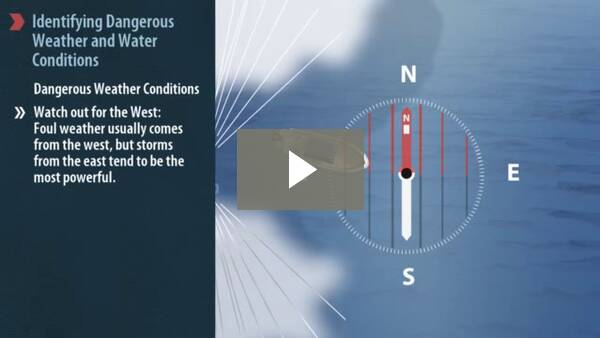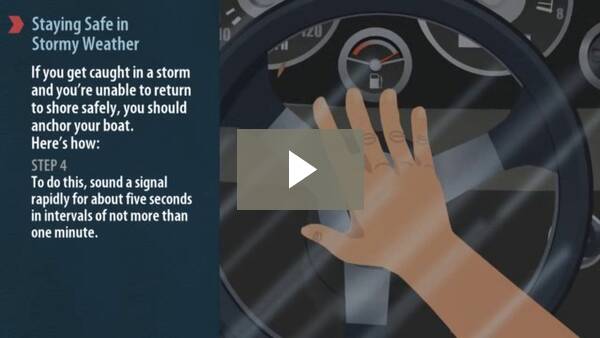Checking the Weather and Water
Keeping an eye to the sky is an important part of planning any outdoor adventure. In many cases, both your safety and your enjoyment of the outdoor trip will depend entirely on the weather conditions. Check the weather forecast before you leave the dock–but be aware that the weather can change very rapidly. Thunderstorms can roll in as ‘fast as lightning’. So, what’s the best practice for tackling bad weather? Be prepared for it.
Boater Skill Level and Poor Weather Conditions
All boat operators require a basic level of skill and competency to operate a boat safely. However, if you get caught in bad weather, you will need advanced operating skills in order to return to the dock safely. This is particularly true if your boat is difficult to navigate in rough water (such as flat-bottom boats). Only risk operating your boat in bad weather if you are confident that you can handle the pressure. Otherwise, make the smart choice to stay on shore.
Statistics tell us that most boating accidents occur during good weather conditions. When you combine poor weather conditions with low boater skill level and an unexpected emergency, the results can be disastrous. Never compromise your safety by boating in bad weather.
Safe Boating Tip:
Know your boat’s range and plan your trip accordingly to stay within it. Know if the distance you plan on travelling will take you 5 minutes or 2 hours!
Using Weather and Water Reports
Find the latest weather reports by turning on your T.V., tuning into your VHF FM radio, or going online. You should also check the weather the good, old-fashioned way—go outside and take a good look at the sky and the water! Avoid having to deal with severe weather by doing your homework and finding the weather report BEFORE you leave the dock!
It’s the boat operator’s responsibility to decide whether to continue or to make adjustments to a trip if the weather forecast is less than ideal.
Official weather reports for boaters are provided through the NOAA (National Oceanic and Atmospheric Administration). You can listen to the NOAA’s weather updates on the radio on the following stations:
- WX1 (162.550 MHz).
- WX2 (162.400 MHz).
- WX3 (162.475 MHz).
The NOAA provides a visual alert system to warn boaters when weather and or/water conditions become dangerous.There are four warning signs that are used during the day and four warnings lights that are used at night:
Small Craft Advisory:
A warning of weather conditions that may be dangerous for small boats. This warning indicates winds of at least 18 knots (24 mph) and rough, wavy conditions.
Gale Warning:
A warning of strong winds within the range of 34-47 knots (39-54 mph).
Storm Warning:
A warning of winds within the range of 48-63 knots (55-73 mph).
Hurricane Warning:
A warning that indicates hurricane winds of 64 knots (74 mph) and higher. This warning identifies that a combination of dangerously high water and rough seas are expected to impact a specified coastal area.
Dangerous Weather and Water Conditions
Although you should always check the official weather forecast before you go boating, you should always be watching out for the development of any of these dangerous conditions:
- Fog, dark clouds and lightning.
- A falling barometer (If the barometer falls, you can expect rain to fall too).
- A noticeable halo around the sun or moon (this usually indicates rain).
- Changes in the direction and temperature of the wind (a drop in temperature indicates a storm).
- Puffy, vertically rising clouds.
- Watch out for the West: Foul weather usually comes from the west, but storms from the east tend to be the most powerful.
Dangerous Water Conditions
In addition to the dangerous weather conditions you should be watching out for when boating, you should also keep an eye for any of these dangerous water conditions:
- High water: After heavy rainfall, flooding rivers or tide changes, high water can camouflage obstacles in the water that would normally be visible.
- Sand bars: Watch out for these shallow water areas that can damage your boat.
- Strong currents: Currents can make swimming very dangerous and will make boat navigation difficult.
- Large waves: A heavy-looking sea is a sign of a storm and large waves could swamp your boat.
Staying Safe in Stormy Weather
If you get caught in a storm, take the following actions:
Step 1) Make sure every passenger is wearing a life jacket.
Step 2) Reduce your speed and maintain your movement forward.
Step 3) Turn on your required navigation lights—you may not be the only boater out there.
Step 4) Seat your passengers on the bottom of the boat, along the centerline. This will help stabilize the boat and prevent your passengers from falling overboard.
Step 5) Stow away any loose gear. A wakeboard or fishing pole can catch the wind and fly at you or your passengers.
Step 6) Cut through large waves at a 45° angle—this will reduce the chance of your boat being swamped by them. If you’re operating a PWC, cut through the waves at a 90° angle to help maintain lateral stability.
Step 7) Keep the bilges free of water in order to stay well above water level (make sure you have a good bailer or working bilge pump on board).
Step 8) If it’s safe to do so, head towards shore.
If you get caught in a storm and you’re unable to return to shore safely, you should anchor your boat. Here’s how:
Step 1) Angle the boat as though you were still moving, at a 45° angle, headed into the waves. This positioning will prevent the boat from drifting or from being swamped by waves.
Step 2) Drop the anchor from the bow of the boat.
Step 3) Stay low in the boat and turn off the electrical equipment while you wait for the storm to pass.
Step 4) Use your sound signalling device to indicate to other boaters that you’re at anchor. To do this, sound a signal rapidly for about five seconds in intervals of not more than one minute.
Step 5) If you find yourself in need of rescue, use the appropriate visual distress signal equipment.
Step 6) If you find yourself without an anchor, the Coast Guard recommends using a bucket and rope as an emergency anchor.
Note: If you cannot reach your destination safely, you should seek shelter for the duration of the storm. Safe shelters include marked areas for mooring or bays and docking areas that are protected by breakwaters.
Checking For Local Hazards
Every waterway in the U.S. has its own unique hazards. For this reason, you must keep marine charts on your boat at all times. Make sure that you consult them before entering a new waterway.
Local hazards could include trees, rocks, sandbars, etc. It’s also a good idea to talk to local operators. Locals may be able to offer you tips not shown on your marine chart, like the location of a tree that recently fell to create a NEW obstacle or a great beach area where you could anchor and spend the day swimming!
Note: Remember that local hazards change frequently and can be found in every type of waterway, including lakes, ponds, rivers and oceans.












